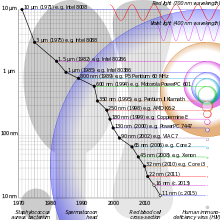- 1 micrometre
-
Semiconductor
manufacturing
processes
Half-nodes Comparison of sizes of semiconductor manufacturing process nodes with some microscopic objects and visible light wavelengths. At this scale, the width of a human hair is about 10 times that of the image.[1]
Comparison of sizes of semiconductor manufacturing process nodes with some microscopic objects and visible light wavelengths. At this scale, the width of a human hair is about 10 times that of the image.[1]
To help compare different orders of magnitude this page lists some items with lengths between 10−6 and 10−5 m (between 1 and 10 micrometres, or µm).
Distances shorter than 1 µm
- ~0.7–300 µm — Wavelength of infrared radiation
- 1 µm — the side of square of area 10−12 m²
- 1 µm — edge of cube of volume 10−18 m³ (one fL.)
- 1–10 µm — diameter of typical bacterium
- 1.55 µm — wavelength of light used in optical fibre
- 3–4 µm — size of a typical yeast cell
- 3–5 µm — size of a human spermatozoon's head (radius by length)[citation needed]
- 6 µm — anthrax spore
- 7 µm — diameter of the nucleus of typical eukaryotic cell
- about 7 μm — diameter of human red blood cells [2]
- 3–8 µm — width of strand of spider web silk[3]
- 8 µm — width of a chloroplast
- 9 µm — thickness of the tape in a 120-minute compact cassette.
- about 10 µm — size of a fog, mist or cloud water droplet
Distances longer than 10 µm
See also
Orders of magnitude for length in E notation shorter than one metre: <−24 −24 −23 −22 −21 −20 −19 −18 −17 −16 −15 −14 −13 −12 −11 −10 −9 −8 −7 −6 −5 −4 −3 −2 −1 0 longer than 1 metre: 1 2 3 4 5 6 7 8 9 10 11 12 13 14 15 16 17 18 19 20 21 22 23 24 25 26 Notes
- ^ Graham T. Smith (2002). Industrial metrology. Springer. pp. 253. ISBN 1852335076.
- ^ DNA From The Beginning, section 6: Genes are real things., "Amination" section, final slide
- ^ Gordon Ramel. "Spider Silk". http://www.earthlife.net/chelicerata/silk.html. Retrieved 2008-12-04. "garden spider silk has a diametre of about 0.003 mm ... Dragline silk (about .00032 inch (.008 mm) in Nephila)"
Categories:
Wikimedia Foundation. 2010.
